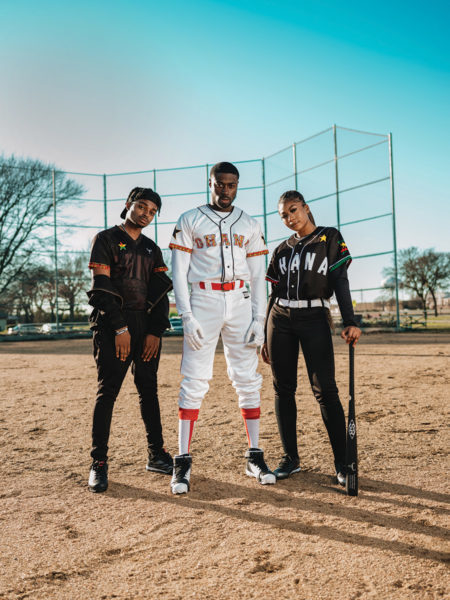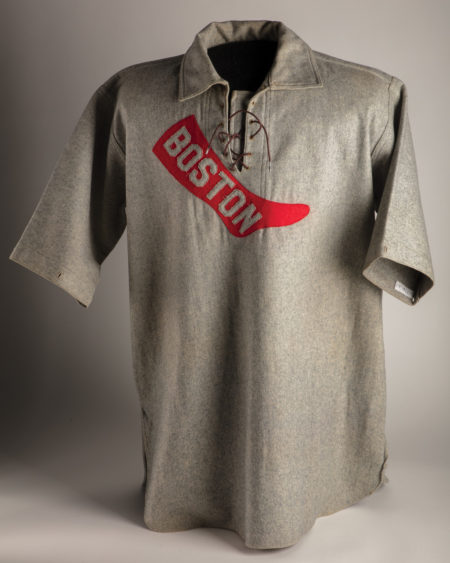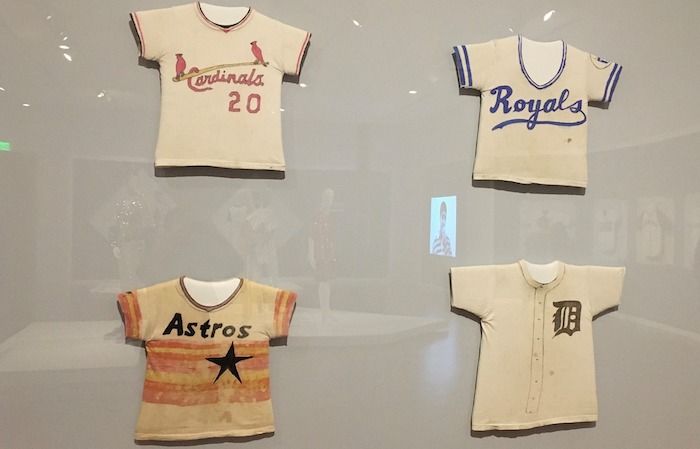It’s not too late to catch this home-run exhibition that’s about a whole lot more than only baseball at the Worcester Art Museum
It seemed like a logical move at the time: In 1908, the Boston Red Sox debuted jerseys that actually incorporated the team’s name. A single red sock graced the front of the jerseys.
However, the new look got a thumbs-down from the Boston sports media, and went into the dustbin of history. Now this design is back on display as part of a groundbreaking exhibition that illuminates the history of baseball’s beloved garments: “The Iconic Jersey: Baseball x Fashion,” at the Worcester Art Museum (WAM).
“It’s the first time you’ve seen this garment being talked about in terms of fan culture, pop culture status, a deep dive into the design of the garments,” Erin Corrales-Diaz, the curator of the exhibition, said in a phone interview.
This exhibition has something for everyone. For baseball history buffs, there are items like the ill-fated 1908 Red Sox jersey once worn by Jesse Tannehill, and a 1952 jersey worn by St. Louis Cardinals Hall of Famer Stan Musial. Other jerseys indicate the growing bond between baseball and fashion, such as a replica of the glittering uniform Elton John wore during his 1975 Dodger Stadium concerts immortalized in the film Rocket Man, and photos of hip-hop artists like OutKast making jerseys into a trend in the genre.

There are also jerseys that show their increasing use by both designers and the public as a vehicle to promote social justice, from honoring Black Lives Matter to recognizing Japanese-Americans who were interned in camps across the US during World War II. One jersey has an especially poignant Boston connection, as it remembers the Boston Marathon bombing attacks of 2013.
Up since June and running through September, the exhibition was inspired by the newest team in Worcester—the Worcester Red Sox or “Woo Sox,” a minor-league affiliate of the Boston Red Sox. The Triple-A team recently relocated to Worcester from Pawtucket, RI. The Woo Sox play their home games in the brand-new Polar Park, named for the locally-based beverage company.
“We borrowed a Worcester Red Sox jersey to have in the show,” Corrales-Diaz noted, “thinking about sort of cross-institutional promotions between the ballpark and museum.”
The entire exhibition is on loan, including about 10 jerseys and two pieces of ephemera from the National Baseball Hall of Fame and Museum in Cooperstown, NY. The Smithsonian Institute also stepped in to help, including with the Musial jersey.
“Most [museum exhibitions] sort of start from their permanent collection and expand outward,” Corrales-Diaz said. “Because of the construction of Polar Park and our desire to do a baseball-related exhibit, we did not have [items] and had to borrow historical garments.”
Some of her favorite pieces are not jerseys, but rather stencils that were once used to create them. The stencils and their accompanying felt samples were made by the R.J. Liebe Athletic Lettering Company of St. Louis, which dates back to 1923.
“The stencils of the jerseys themselves are material that has never been seen before in an art museum,” Corrales-Diaz said.
Created by the husband-and-wife team of Robert and Alice Liebe, the company made “all of the lettering for the Cardinals jerseys and began doing more and more major league lettering for teams,” she said, adding that while jerseys are usually associated with manufacturers such as Spalding, “one of the aspects I really wanted to bring forward is how many different hands had a role in making the garments.”
Asked whether there were any Worcester-based companies involved in manufacturing baseball jerseys, Corrales-Diaz said that she had not found any, but there were some elsewhere in New England, such Stall and Dean, which has its roots in Brockton, or Draper & Maynard of New Hampshire.
“It was so critical to a lot of towns,” she said, noting that Draper & Maynard “basically supported an entire town with the construction of sporting goods. There’s the manufacturer Stall and Dean. You don’t see it at all in Worcester, although it has a long tradition and history in terms of the manufacture of garments.”
Corrales-Diaz, who has a PhD in art history from the University of North Carolina at Chapel Hill, came to Worcester after being a faculty member in Ohio and South Carolina.
“I always had one foot in the door of museums,” she said, noting that Worcester itself is “great,” with “so much to do … every weekend, there might be a fair, a play, you can go to a restaurant, there are so many great restaurants … there’s a new public market as well. There’s so much energy in the city. It feels like there’s not enough day and night to take in everything Worcester has to offer.”
So far, visitors have been taking to the exhibition. “One of their comments: ‘I had no idea this was a way you can look at an object, I had no idea there was an artistry behind them,’” Corrales-Diaz said.
The Elton John replica jersey is one of the curator’s personal favorites, even if the museum couldn’t access the original. For longtime Red Sox fans, “Rocket Man” has another meaning—it was a staple at Fenway Park when Roger Clemens pitched there. Yet this jersey is a throwback of a different kind.
“It was a really pivotal moment in terms of designers looking at the baseball jersey, the baseball uniform, as source material, a source of inspiration,” Corrales-Diaz said.
Fashion designers have also used baseball jerseys to promote messages of social justice. In 2017, Japanese-American designer G Yamazawa and Runaway teamed up to create a jersey that commemorated the experiences of Japanese-Americans from a painful moment in history.
“It honors Japanese-American baseball players incarcerated at Heart Mountain, Wyoming, during World War II,” Corrales-Diaz said.

The US government had relocated Japanese-Americans deep inland, and some of them played baseball at the camp—“America’s favorite pastime,” Corrales-Diaz noted. “It’s an aspect of baseball history that’s been forgotten about.”
She also pointed to jerseys honoring BLM and the Negro Leagues, including a Kansas City Monarchs replica jersey on display.
“There are a lot of the decisions you make as a fan about your desire to wear a jersey,” Corrales-Diaz said. “To commemorate a player, a Hall of Famer. A throwback jersey.” With the Kansas City Monarchs jersey, “you’re really emphasizing, wanting to talk about a particular aspect of history. The conversation starts. It’s a way to spark some interest and discuss baseball’s history of segregation.”
In the late 20th century, the baseball jersey also became a must-have in the music world.
“It was a particular favorite among hip-hop stars,” Corrales-Diaz said, citing photos in the exhibition of Big Boi wearing an Atlanta Braves jersey and Jay-Z in a New York Yankees jersey.
As the exhibition shows, when it comes to the baseball jersey, some trends don’t last, others have staying power, and still others are timeless—like the advice given by one of baseball’s early enthusiasts, Henry Chadwick, in the 19th century.
“One of the quotes I selected,” Corrales-Diaz said, “was from Chadwick in 1869: ‘One of the most important things as a team is to be well-dressed.’”
Rich Tenorio is a writer and editor whose work has appeared in international, national, regional and local media outlets. He is a graduate of Harvard College and the Columbia University Graduate School of Journalism. He is also a cartoonist.


